Segment Your Audience Like a Pro Using CRM List Management

Heading 1
Heading 2
Heading 3
Heading 4
Heading 5
Heading 6
Lorem ipsum dolor sit amet, consectetur adipiscing elit, sed do eiusmod tempor incididunt ut labore et dolore magna aliqua. Ut enim ad minim veniam, quis nostrud exercitation ullamco laboris nisi ut aliquip ex ea commodo consequat. Duis aute irure dolor in reprehenderit in voluptate velit esse cillum dolore eu fugiat nulla pariatur.
Block quote
Ordered list
- Item 1
- Item 2
- Item 3
Unordered list
- Item A
- Item B
- Item C
Bold text
Emphasis
Superscript
Subscript
Segment Your Audience Like a Pro Using CRM List Management
.png)
N Suresh
Join us on November 6th as Mr. Yash Mishra, Product Manager, Fatakpay, reveals the precise strategies that eliminates the speed trap and guarantees a 30% conversion boost.
If you’ve ever, at some point during your campaigns, asked yourself: “Why isn’t anyone clicking?” or “How do I make sure the right people actually see my email?” This blog is for you.
Smart segmentation and strategic CRM list management can be your saviour, simply because sending emails to everyone is easy, but sending to the right ones is where results happen. Segmented email campaigns result in 30% more open rate and 50% more clicks than non-segmented ones. 78% of marketers consider audience segmentation the most powerful way to improve email results.
In this blog, we’ll unpack the real picture behind these numbers and show you how to build segmented lists that actually convert.
What is Audience Segmentation?
Audience segmentation is the process of dividing your master contact list into smaller, more relevant subgroups based on shared characteristics like behavior, demographics, interests, or purchase intent. These segments allow businesses to deliver more personalized, relevant, and timely messaging to each group, rather than using a one-size-fits-all approach. Instead of speaking to everyone in the same tone, segmentation lets you talk directly to the people who actually care, in a language they understand.
The impact of audience segmentation
- More Revenue: Personalized email campaigns generate 6X higher transaction rates than generic emails.
- Improved ROI: Brands using advanced segmentation see a 76% lift in ROI on their email marketing efforts.
- Enhanced customer loyalty: Personalized experiences foster stronger relationships and increase customer loyalty.
- Increased engagement: Segmented emails lead to 94% higher open rates and 38% more click-through rates (CTR) than non-segmented ones, resulting in higher conversion and overall engagement.
Common Types of Audience Segmentation
With powerful CRM list management tools, you can strategically group your audience into marketing lists that are primed for relevance, timing, and conversion. The goal is to achieve meaningful, actionable email list segmentation that’s built around how people think, feel, act, and buy.
Here are the most effective types of audience segmentation you can perform on your marketing list:
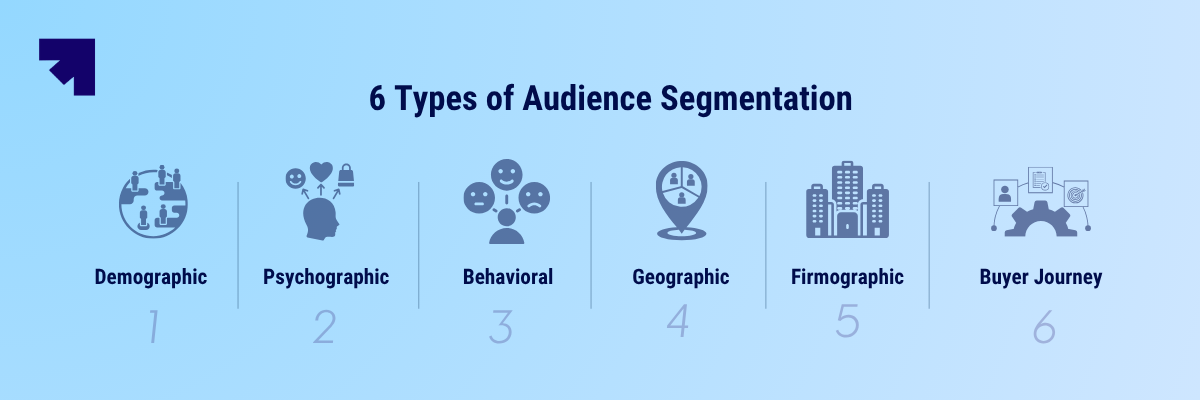
1. Demographic Segmentation
Dividing based on demographics is one of the most widely used forms of segmentation. You divide your audience based on factors like age, gender, income level, education, occupation, and marital status. It’s basic, but still works.
Example: A finance app might create different campaigns for college students, mid-career professionals, and retirees because each group’s goals and language are wildly different.
2. Psychographic Segmentation
This dives deeper into customer segmentation based on lifestyle choices, values, personality traits, attitudes, and interests. It helps tailor messaging to emotional drivers and intrinsic motivations.
Example: A fitness brand could speak differently to someone who wants to feel good and stay active vs. someone training for a triathlon.
3. Behavioral Segmentation
Behavior tells the truth. Segmenting based on how users behave and the actions they perform, like cart abandonment, browsing behavior, or email clicks. This helps you nurture them with the right nudge.
Example: Someone who added a product to their cart but didn’t buy it is a perfect trigger for a tailored, urgency-driven follow-up email.
4. Geographic Segmentation
This segmentation groups contacts by country, region, city, postal code, or even climate zone. It’s especially useful to run location-based offers or regional campaigns.
Example: A CRM list for a fashion retailer could send promotions to specific regions based on their native festivals or occasions.
5. Firmographic Segmentation
Primarily used for B2B campaigns, this form of segmentation focuses on company-specific data like industry, company size, revenue, or job title.
Example: A CRM can segment prospects into “Startups,” “SMBs,” and “Enterprises” to adjust value propositions and pricing models accordingly.
6. Buyer Journey Segmentation
This is one of the most powerful yet underutilized segmentation types. It aligns contacts to where they are in their buying journey.
- Awareness: Potential buyers who are just discovering the problem
- Consideration: Potential buyers comparing options before making a decision
- Decision: They are now ready to buy
Example: In a CRM, a lead who downloaded an eBook could go into a nurturing sequence in the consideration stage, while someone who requested a demo moves into a decision stage offer.
When synced with CRM list management, journey-based segmentation ensures that the content, timing, and CTA fit where the customer is, making campaigns more timely and actionable.
Why Audience Segmentation is Important
Simply talking to your audience isn't sufficient for an effective business, but making them feel like you’re talking to them is. That’s the core value of segmentation.
Here’s exactly what audience segmentation powered by CRM list management helps you achieve:
- Personalized Marketing: When you speak to what your audience actually cares about, they pay attention.
- Improved Engagement: Segmentation gives every click, open, and reply a reason. Because when people feel like the message was made for them, they act on it. 36% of consumers open emails due to personalized content, a 227% increase year-over-year.
- Better response rates and lower acquisition costs: By targeting the right audience, you spark stronger responses and lower the cost of acquiring new customers.
- Enhanced Targeting: Segmented emails reach the right people with the right message at the right time, leading to higher open rates, stronger CTRs, and better ROI.
- Increased Brand loyalty: When your customers truly feel seen and valued, their loyalty deepens, and they choose your brand repeatedly.
- Uncovering Opportunities: Segments can reveal untapped audiences or behaviors you didn’t know existed, turning hidden patterns into revenue-driving actions.
- Competitive Advantage: Companies that segment effectively can differentiate their messaging and positioning, making their brand stand out.
- Maintain List Hygiene and Compliance: Reduce bounces, remove inactive contacts, and maintain GDPR/CAN-SPAM compliance through regular, automated segmentation filters.
What is CRM List Management?
So now that we understand the what and why of audience segmentation, the next question is, how do you actually manage and execute it at scale? And that’s where CRM list management comes in.
CRM list management refers to organizing and maintaining segmented contact groups in your CRM by demographics, behavior, purchase stage, and more, rather than static contact spreadsheets. So, what sets it apart from ordinary contact lists?
Unlike generic contact lists that sit idle and go stale, CRM powered lists are living and breathing assets. Here’s why:
- Dynamic: Your CRM lists evolve in real-time as your customers engage. No manual cleanup needed.
- Data-richness: They combine behavior, preferences, and history from across touchpoints to build a deeper customer context.
- Precision: Instead of one-size-fits-all outreach, you target the exact right segment with the exact right message.
- Automated: Your CRM can automatically trigger workflows, emails, and list updates, so you stay relevant without lifting a finger.
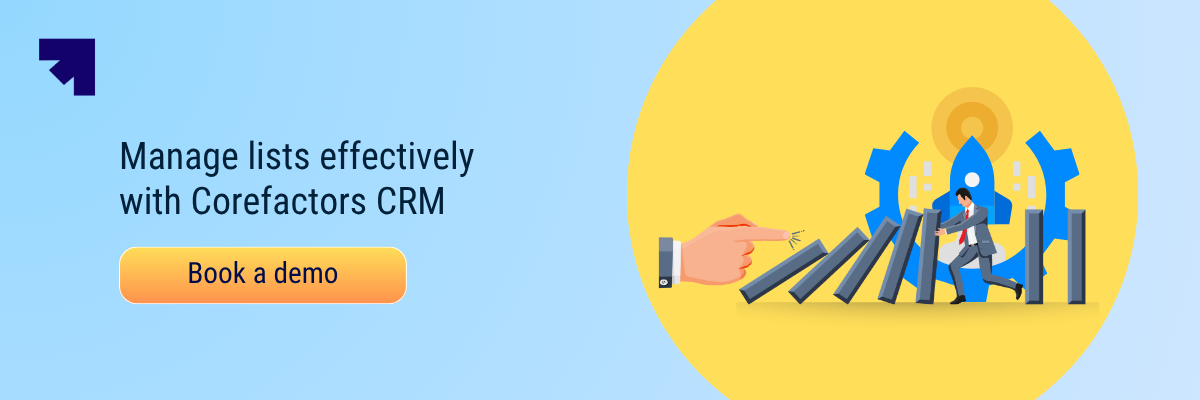
Types of CRM Lists
Understanding the different types of CRM lists helps you organize contacts effectively and target them with precision. Here are the main CRM list types you’ll use to segment and manage your audience:
- Contact List: The complete database that includes everyone in your CRM, from leads and customers to partners and vendors. It’s your master list.
- Lead List: These are potential customers who have shown interest but haven’t yet made a purchase. Use this list to nurture prospects and move them down the funnel.
- Customer List: These are contacts who have already converted. Segmenting them helps with upselling, retention campaigns, and personalized offers.
- Opportunity List: These are contacts who have already converted. Segmenting them helps with upselling, retention strategies, and personalized offers.
Each list serves a unique purpose in your marketing and sales strategy. With smart CRM list management, you can fluidly move contacts between these lists based on their actions, interests, and journey stage, keeping your campaigns targeted and effective.
Using CRM List Management for Audience Segmentation: A Step-by-Step Guide
Targeted marketing using customer segmentation works when it's strategic and not scattered. Here’s how to use your CRM to segment with precision and turn messy contact databases into dynamic revenue-generating lists.
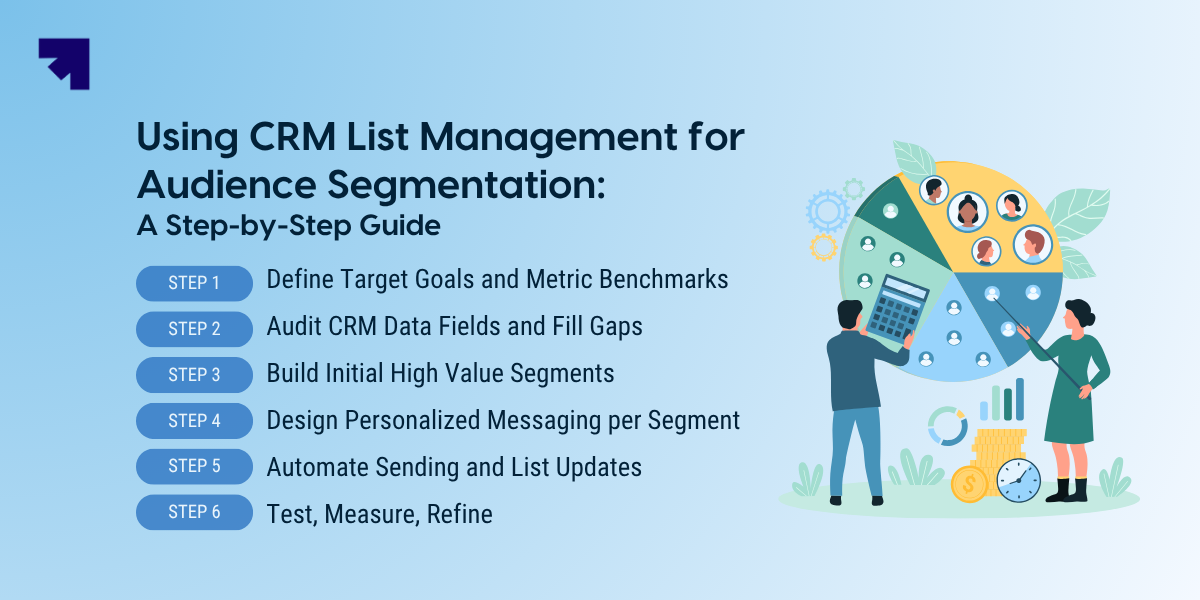
Step 1: Define Target Goals and Metric Benchmarks
Before you slice up your audience, ask: What exactly do we want from this segment?
Every segment should tie back to a business objective; be it more demo bookings, better upsell conversions, or reactivating cold leads.
- Align each segment with a buyer journey stage, such as awareness, consideration, and decision.
- Define your success: Is it a 20% open rate? A 15% CTR? Or a 10% conversion to SQL?
- Set benchmarks so you know what’s working and what’s not.
Step 2: Audit CRM Data Fields and Fill Gaps
Your segmentation is only as good as your data. A CRM filled with scattered or shallow data points will never help you segment smartly, but instead gives you noise.
- Audit your current CRM fields. Ensure they are structured and complete.
- Make sure every form and integration is capturing data that maps to your segmentation goals, like industry, behavior, and preferences.
- Once you identify the gaps, use tools like progressive profiling, enrichment APIs, or short audience surveys to start filling in the blanks.
- Flag data fields into “segmentation-ready,” “needs review,” or “missing,” and that can be act as your roadmap.
Step 3: Build Initial High Value Segments
Now that your data is in shape, it’s time to build. Start small and start smart. You don’t need 20 segments, but the right three to five that map directly to your marketing objectives.
- Base them on high-impact goals: new lead nurturing, win-back campaigns, loyalty boosts.
- Use multiple filters: don’t just go “location + job title.” Go deeper like “past purchase + email engagement + industry.” For example: “Decision-makers in tech companies who’ve downloaded a pricing guide in the last 30 days.”
- Use lead scoring or recent activity to prioritize which segments deserve immediate focus.
Step 4: Design Personalized Messaging per Segment
Now that you know who you’re talking to, say what matters to them.
- Craft content that speaks the language of each segment, like their goals, fears, challenges, and triggers.
- Personalize everything from subject lines, content, and CTAs based on what that specific segment cares about.
- Match tone and messaging to their buyer journey stage: For awareness, focus on educating. For consideration, address objections. For decisions, highlight urgency and value.
Step 5: Automate Sending and List Updates
Manual segmentation has now become outdated with the influx of automation.
- Use triggers like page visits, downloads, or form fills to auto-sort contacts into the right segments.
- Set up workflow automation to add contacts to segments, trigger relevant email flows, remove disengaged users or soft bounces, and update fields as new data is collected.
Step 6: Test, Measure, Refine
Effective segmentation is an evolving engine.
- Once campaigns are live, analyze them by segment. Monitor which group opens more, who clicks less, and the average conversion rate.
- A/B test subject lines, send times, offers across segments, and let data guide your next moves.
- Update your filters, restructure underperforming segments, and refine automation flows based on what the numbers show.
Advanced Tips for Targeted Marketing using Customer Segmentation
Basic segmentation is a solid start to get your message to the right crowd. But if you really want to see results, you’ll need advanced tactics. By combining the right tools, CRM adoption trends, smart data, and a bit of intuition, you can craft highly specific audience slices that feel like they were built just for your customer.
Here’s how to do it:
- Use AI to Predict, Personalize, and Prioritize: Use AI-driven models to forecast churn rates, predict purchase behavior, and score leads for laser-focused outreach. For example, a subscription service can identify users likely to cancel and send targeted retention offers.
- Build Hybrid Segmentation Models: Combine demographic, psychographic, and behavioral data to create nuanced, hyper-relevant audience slices.
- Leverage Integrations: Let your tools talk to themselves because segmentation gets more powerful when your systems are connected. You can sync your CRM with your e-commerce platform, feedback tools, and survey data to enrich segments and personalize at scale. For instance, integrate purchase history with customer feedback to craft product recommendations.
- Channel Optimization: Not every message needs to be an email. Some customers prefer a quick WhatsApp message. Others like to sit down with an email newsletter. Use past behavior to decide where and how you show up; whether it’s email, SMS, WhatsApp, or others for maximum impact. For example, send product tips on WhatsApp for those who opted in, while keeping loyal email subscribers in the loop with monthly recaps.
Best Practices for Audience Segmentation and List Management
To ensure your campaigns stay sharp, scalable, and impactful, follow the audience segmentation and CRM list management best practices mentioned below:
- Make segments actionable: Don’t go too broad or too specific. Find a balance where your segments are meaningful and scalable.
- Target 3 to 5 key criteria: Too many layers and you risk overcomplicating things. Stick to what matters most for that campaign's goal.
- Maintain CRM hygiene: Inactive contacts, typos, and duplicates add clutter and kill deliverability. Run regular hygiene checks.
- Automate list updates and cleanup: Set smart workflows to move people in and out of segments based on actions they take or don’t take.
- Regularly run performance audits: Check campaign results by segment often. You might find that one group loves discount emails while another ignores them but responds to exclusive content.
Metrics and KPIs to Track Audience Segmentation Success
Tracking the right email marketing metrics is crucial to know if your audience segmentation strategy is actually working. Here are the key performance indicators you should monitor :
- Engagement Rate: Measure open rates, click-through rates (CTR), and reply rates within each segment. These numbers reveal how well your messaging resonates.
- Conversion Flow: Track the journey from Marketing Qualified Lead (MQL) to Sales Qualified Lead (SQL), and finally to sale, segmented by audience groups to see which segments drive real pipeline growth.
- Retention and Churn Rates: Measure how long customers stay active and where drop-offs happen within each segment. This insight helps you proactively target at-risk groups with retention efforts.
- Revenue by Segment: Break down into segment-specific lifetime value (LTV) and average order value (AOV) to understand which groups bring the most financial impact and deserve your focus.
Turn CRM Lists into Revenue
Audience segmentation can be your significant strategic advantage if used correctly. When you leverage your CRM’s list management to segment smarter, you transform raw contact data into powerful, revenue-driving assets.
By targeting the right people with the right message at the right time, beyond improving open rates or clicks, you build lasting customer relationships, boost conversions, and scale your ROI. Start by setting clear goals, keeping your data clean, and automating where it makes sense.
Don’t let your CRM data sit idle; unlock its full potential with smart segmentation strategies today. If you're ready to stop sending one-size-fits-all emails and start building meaningful, targeted campaigns that convert, Corefactors: A RevOps-enabled CRM solution is built to make it simple and powerful.
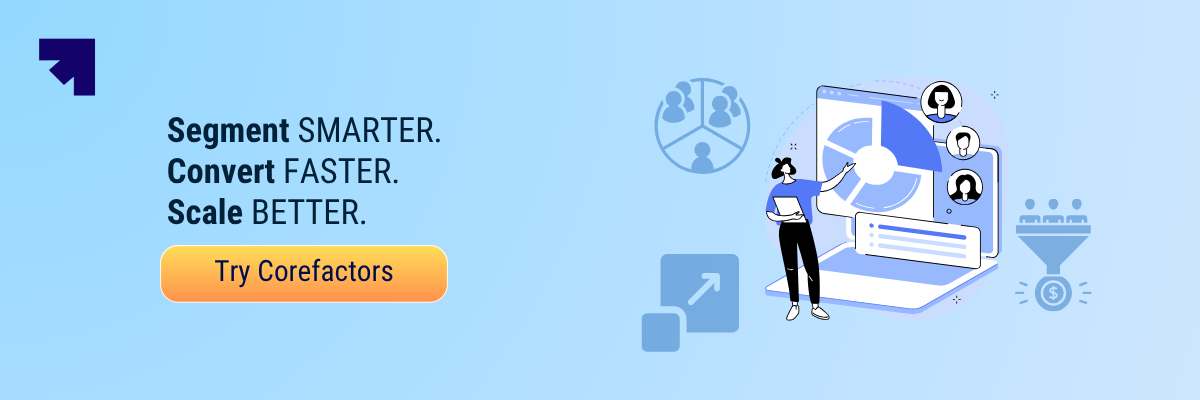
Heading 1
Heading 2
Heading 3
Heading 4
Heading 5
Heading 6
Lorem ipsum dolor sit amet, consectetur adipiscing elit, sed do eiusmod tempor incididunt ut labore et dolore magna aliqua. Ut enim ad minim veniam, quis nostrud exercitation ullamco laboris nisi ut aliquip ex ea commodo consequat. Duis aute irure dolor in reprehenderit in voluptate velit esse cillum dolore eu fugiat nulla pariatur.
Block quote
Ordered list
- Item 1
- Item 2
- Item 3
Unordered list
- Item A
- Item B
- Item C
Bold text
Emphasis
Superscript
Subscript
Frequently Asked Questions (FAQs)
What is CRM list management and why does it matter?


CRM list management is the process of organizing, segmenting, and updating your contact database to send the right message to the right audience. It ensures relevance, accuracy, and better conversion.
How does audience segmentation improve email campaigns?


Audience segmentation tailors your messaging to different customer groups, increasing engagement and click-throughs by making your content feel personalized and timely.
What’s the difference between CRM list management and a basic email list?


CRM list management uses dynamic, behavior-based data to update and automate segments, while basic email lists are static and lack email personalization or automation features.
Can audience segmentation reduce email unsubscribes?


Yes, targeted content from effective audience segmentation reduces irrelevant messages, which leads to fewer unsubscribes and stronger email retention.
How often should I update my CRM list management strategy?


Review your CRM list management strategy monthly to remove inactive users, refine segments, and adapt to changes in customer behavior or market trends.







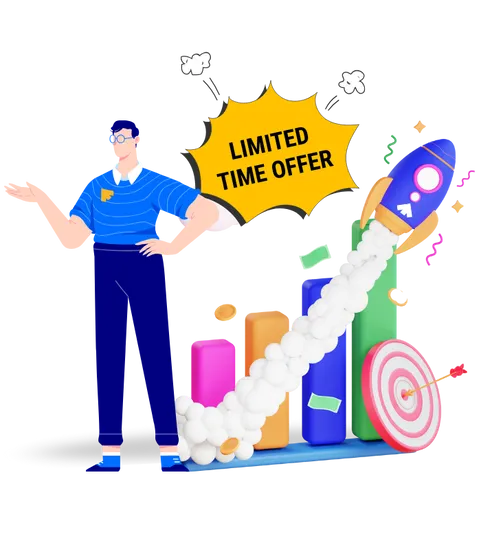











.png)




.png)